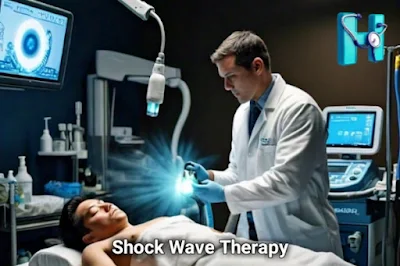Shock Wave Therapy
In today's fast-paced world, finding effective treatments for various health conditions is paramount. One such groundbreaking therapy gaining attention is Shock Wave Therapy (SWT). This innovative approach utilizes shock waves to stimulate the body's natural healing process, offering relief from various ailments. Let's delve deeper into the world of SWT and uncover its remarkable benefits.
Understanding Shock Wave Therapy
What is Shock Wave Therapy?
Shock wave therapy is a medical treatment used to address various musculoskeletal conditions without invasive procedures. It involves using acoustic waves, generated outside the body, and directed towards the affected area to stimulate healing. These high-energy waves induce microtrauma in the targeted tissue, prompting the body's natural healing response.
How Does Shock Wave Therapy Work?
Shock wave therapy works by delivering high-energy acoustic waves to the affected area. These waves create microtrauma in the tissue, stimulating the body's natural healing mechanisms. This includes increased blood flow, formation of new blood vessels, and enhanced tissue regeneration. The therapy can help alleviate pain, reduce inflammation, and promote healing in conditions such as tendonitis, plantar fasciitis, and muscle injuries.
Types of Shock Wave Therapy:
Focused shock wave therapy concentrates the energy at a specific point, making it suitable for treating localized issues like tendonitis or plantar fasciitis.
Radial shock wave therapy disperses energy over a larger area, making it ideal for broader conditions such as muscle pain or cellulite reduction. Each type has its own applications and benefits depending on the patient's condition and treatment goals.
Applications of Shock Wave Therapy
Shock wave therapy has a wide range of applications across various medical fields. It is commonly used in orthopedics to treat conditions such as tendonitis, bursitis, and plantar fasciitis. In sports medicine, shock wave therapy helps athletes recover from injuries faster and improve performance by promoting tissue healing and reducing pain. Additionally, shock wave therapy is used in urology to treat erectile dysfunction, as well as in dermatology for conditions like cellulite reduction and wound healing. Its non-invasive nature and effectiveness in stimulating tissue regeneration make it a versatile treatment option for many medical conditions.
Pain Management:
Chronic pain can significantly impact the quality of life, and traditional pain management methods may not always provide satisfactory relief. Shock wave therapy offers a non-invasive alternative for alleviating chronic pain by targeting the underlying causes. By promoting tissue healing and reducing inflammation, shock wave therapy helps decrease pain levels and improve mobility in conditions such as tendonitis, arthritis, and fibromyalgia. Its ability to stimulate the body's natural healing processes makes it an effective option for long-term pain management without the need for medication or surgery.
Treating Musculoskeletal Conditions:
Musculoskeletal conditions like tendonitis, bursitis, and calcific rotator cuff tendinitis are commonly treated with shock wave therapy in orthopedics. The high-energy acoustic waves stimulate tissue regeneration and promote healing, reducing pain and improving function. This non-invasive treatment option is especially beneficial for patients who may not be candidates for surgery or prefer to avoid invasive procedures. Shock wave therapy can help accelerate recovery and restore mobility in individuals with various orthopedic issues, enhancing their overall quality of life.
Enhancing Athletic Performance:
Athletes often experience injuries and musculoskeletal issues due to the physical demands of their sport. Shock wave therapy has become a popular treatment option in sports medicine for promoting faster recovery and enhancing athletic performance. By stimulating tissue regeneration and reducing inflammation, shock wave therapy accelerates the healing of sports-related injuries such as muscle strains, tendonitis, and stress fractures. Athletes undergoing shock wave therapy experience less downtime and can return to training and competition sooner, while also reducing the risk of recurrent injuries.
Restoring Vitality and Confidence:
Erectile dysfunction (ED) can have a significant impact on a man's self-esteem and relationships. Shock wave therapy has emerged as a promising treatment option for ED by improving blood flow to the penis and promoting tissue repair. During the treatment, low-intensity shock waves are delivered to the erectile tissue, stimulating the formation of new blood vessels and enhancing penile blood flow. This leads to improved erectile function and increased sexual performance. Shock wave therapy for ED is non-invasive, painless, and does not require medication, offering men a natural and effective solution to restore vitality and confidence in their sexual health.
Benefits of Shock Wave Therapy
Shock wave therapy offers a plethora of benefits that make it a popular choice for individuals seeking relief from various medical conditions.
Non-Invasive Treatment Option:
One of the most appealing aspects of shock wave therapy is its non-invasive nature. Unlike surgical procedures that require incisions and lengthy recovery periods, shock wave therapy involves the application of high-energy acoustic waves externally to the targeted area. This means no needles, no anesthesia, and no risk of infection associated with invasive treatments. Patients can undergo shock wave therapy comfortably and without the need for hospitalization.
Speedy Recovery and Minimal Downtime:
Another significant advantage of shock wave therapy is its ability to promote speedy recovery with minimal downtime. Since the treatment stimulates the body's natural healing processes, patients often experience improvements in their symptoms shortly after undergoing therapy sessions. Unlike traditional treatments that may require weeks or even months of rehabilitation, shock wave therapy allows individuals to resume their daily activities relatively quickly, leading to a faster return to normalcy.
Long-lasting Results:
Shock wave therapy doesn't just provide temporary relief; it offers long-lasting results for many patients. By targeting the underlying causes of various medical conditions, such as tissue damage or inflammation, shock wave therapy promotes lasting improvements in symptoms. This means that patients can enjoy sustained relief from pain, improved mobility, and enhanced overall well-being over an extended period, reducing the need for frequent interventions or ongoing medication use.
Alternative to Surgery and Medications:
For individuals who prefer to explore non-surgical and non-pharmacological treatment options, shock wave therapy serves as a valuable alternative. Whether it's chronic pain, musculoskeletal injuries, or erectile dysfunction, shock wave therapy offers a safe and effective solution without the risks and potential side effects associated with surgery or medications. This makes it an attractive option for those seeking natural and minimally invasive approaches to managing their health conditions.
If summarized, shock wave therapy provides a multitude of benefits, including its non-invasive nature, speedy recovery, long-lasting results, and status as an alternative to surgery and medications. With its ability to address a wide range of medical conditions effectively, shock wave therapy continues to gain recognition as a valuable treatment option for improving patient outcomes and quality of life.
The Science Behind Shock Wave Therapy
Shock wave therapy utilizes high-energy acoustic waves to stimulate healing in various medical conditions. These waves are generated outside the body and directed toward the affected area to trigger a series of biological responses that promote tissue regeneration and pain relief.
Mechanism of Action:
The mechanism of action of shock wave therapy involves inducing controlled microtrauma in the targeted tissue. This microtrauma stimulates the body's natural healing processes, including increased blood flow, formation of new blood vessels, and enhanced tissue regeneration. Additionally, shock wave therapy has been shown to modulate pain perception by affecting nerve activity and reducing inflammation in the treated area.
Stimulating Tissue Regeneration:
Shock wave therapy stimulates tissue regeneration by promoting the production of growth factors and cytokines, which are essential for repairing damaged tissues. The high-energy acoustic waves create microtears in the tissue, prompting the body to initiate a healing response that includes the proliferation of cells involved in tissue repair and remodeling.
Triggering Angiogenesis for Improved Blood Flow:
One of the key effects of shock wave therapy is triggering angiogenesis, the formation of new blood vessels. By stimulating the production of angiogenic factors, shock wave therapy promotes the growth of new blood vessels in the treated area, improving blood flow and oxygenation to the surrounding tissues. This enhanced blood supply facilitates the delivery of nutrients and removal of waste products, further supporting tissue healing and regeneration.
Modulating Pain Perception:
Shock wave therapy has been shown to modulate pain perception by affecting nerve activity and reducing inflammation. The acoustic waves disrupt pain signaling pathways and stimulate the release of endorphins, which are natural pain-relieving substances produced by the body. Additionally, shock wave therapy helps reduce inflammation in the treated area, alleviating pain and discomfort associated with various medical conditions.
Real-life Success Stories
Real-life success stories provide firsthand accounts of individuals who have benefited from shock wave therapy (SWT). These stories often highlight the transformative impact of SWT on patients' lives, showcasing the effectiveness of the treatment in addressing various medical conditions. Success stories may feature individuals who have experienced significant pain relief, improved mobility, and enhanced quality of life after undergoing SWT. By sharing their experiences, these individuals inspire hope and optimism among others considering SWT as a treatment option.
Testimonials from Patients:
Testimonials from patients offer valuable insights into their experiences with shock wave therapy. These testimonials typically include personal anecdotes, describing the symptoms or conditions that led them to seek treatment, their journey through SWT, and the outcomes they achieved. Patients may express gratitude for the relief they have experienced from chronic pain, the restoration of function in injured or damaged tissues, or the improvement in their overall well-being. Hearing directly from patients who have undergone SWT can provide reassurance and encouragement to others considering the treatment.
Demonstrating the Efficacy of SWT:
Case studies serve as compelling evidence of the efficacy of shock wave therapy in clinical settings. These studies typically document specific patient cases, detailing the diagnosis, treatment approach, and outcomes following SWT. Case studies may include objective measures such as pain scores, range of motion assessments, and imaging findings to quantify the improvements observed post-treatment. By presenting concrete evidence of the benefits of SWT in individual cases, these studies contribute to the growing body of research supporting its effectiveness across various medical conditions.
Personal Accounts of Recovery:
Personal accounts of recovery offer a glimpse into the transformative power of shock wave therapy in improving patients' lives. These accounts often highlight the emotional journey of individuals who have experienced significant improvements in their health and well-being after undergoing SWT. Patients may describe regaining the ability to participate in activities they once enjoyed, returning to work or sports, or experiencing a renewed sense of vitality and confidence. By sharing their personal stories of recovery, these individuals inspire hope and serve as beacons of encouragement for others facing similar challenges.
Considerations and Precautions:
Before undergoing shock wave therapy (SWT), patients and healthcare providers need to consider certain factors and precautions to ensure the safety and effectiveness of the treatment. These considerations may include assessing the patient's medical history, identifying any contraindications or risk factors, and discussing expectations and goals for the treatment.
Additionally, precautions such as adjusting treatment parameters based on the patient's individual characteristics and monitoring for adverse reactions during and after the procedure are important to minimize potential risks and optimize outcomes.
Ideal Candidates for Shock Wave Therapy:
While shock wave therapy can be beneficial for a variety of medical conditions, not everyone is an ideal candidate for the treatment. Ideal candidates for shock wave therapy typically include individuals who have failed to respond to conservative treatments such as physical therapy, medications, or injections and who have conditions that are amenable to SWT, such as tendonitis, plantar fasciitis, or erectile dysfunction. Additionally, candidates should be in overall good health and have realistic expectations about the potential outcomes of the treatment.
Potential Side Effects and Risks:
Like any medical procedure, shock wave therapy carries potential side effects and risks that patients should be aware of before undergoing treatment. Common side effects may include mild discomfort or bruising at the treatment site, temporary exacerbation of symptoms, or transient numbness or tingling. In rare cases, more serious complications such as tissue damage, infection, or nerve injury may occur. It's important for patients to discuss potential risks with their healthcare provider and to follow post-treatment instructions carefully to minimize the likelihood of adverse outcomes.
Consultation and Evaluation Process:
The consultation and evaluation process for shock wave therapy typically involves a thorough assessment by a qualified healthcare provider to determine the appropriateness of the treatment for the individual patient. This may include reviewing the patient's medical history, performing a physical examination, and ordering diagnostic tests such as imaging studies to confirm the diagnosis and assess the extent of the condition. During the consultation, patients have the opportunity to ask questions, discuss their concerns and goals for treatment, and receive personalized recommendations based on their unique needs and circumstances. Following the evaluation process, patients and healthcare providers can collaborate to develop a treatment plan that is tailored to the patient's specific condition and goals, taking into account any considerations or precautions that may apply.
Conclusion
Shock Wave Therapy offers a promising avenue for individuals seeking effective, non-invasive treatment options. With its diverse applications and numerous benefits, SWT continues to revolutionize the field of healthcare. Embrace the power of shock waves and embark on a journey towards rejuvenation and vitality.
References
American Journal of Sports Medicine
Journal of Orthopaedic Research
International Journal of Impotence Research
#ShockWaveTherapy #SWT #PainManagement #Orthopaedics #Healthcare #Recovery #Wellness










